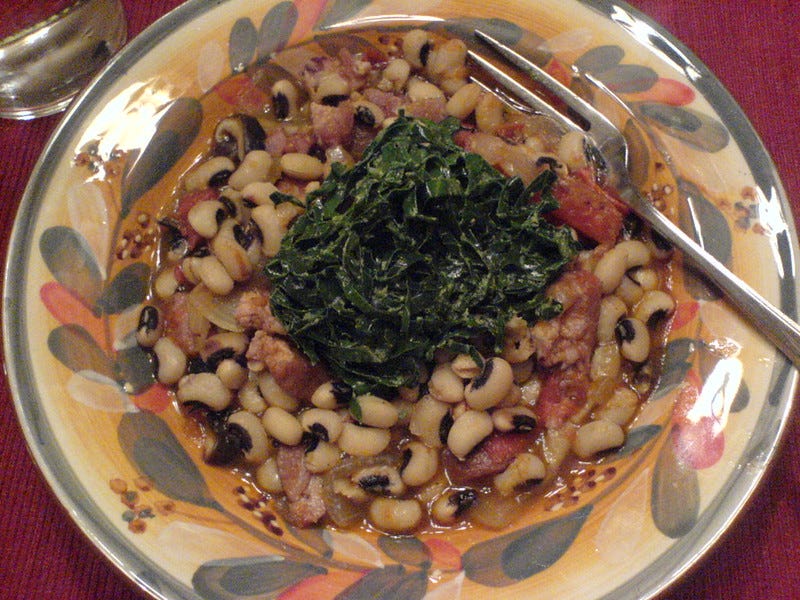Hello, wonderful witches!
Friends, I’m exhausted. There’s an unrelenting heatwave this summer that just saps the energy from me and most people I see on the street. Even as I write this, I’m watching heat lightning flash outside my window—and it’s almost 10 p.m. Today, the heat index reached 106. I’m doing my best to daydream of the colder days that will soon be approaching. I know I should be honoring the summer sun, basking in its glow and saying thanks to the universe that allows us to enjoy it. But every day that passes, I’m getting more and more excited for the frosty days of winter. If only I had a spell to give myself a chill for a few minutes… I’d definitely do it.
Today’s article is an important look into the Black experience, traditional wintertime (in the northern hemisphere at least) Black food, and why it matters far beyond the bounds of New Year’s Eve.
Have you connected with us on social? We’re filling up Facebook, Instagram, and Twitter with Kitchen-Witch-themed posts and shares. Come join us!
Black-Eyed Peas, Collard Greens, and the Black Tradition of Luck
By Nia Tucker

For white Americans, New Year’s Day connotes a day for a fresh start, a way to set resolutions and reminisce on successes from the year past. It’s not to say that Black Americans don’t do the same, but growing up, I remember being told by my family that whatever you do on New Year’s Eve, it sets the tone for the whole year. You have to clean your room, avoid superstitions, and be sure to make the fresh collard greens and black-eyed peas for dinner on the eve of the big night. But, this dish, beyond the holiday, illustrates a long history of Black people in the Americas using spirituality and food to instruct their lives.
Our history with soul food like collard greens and black-eyed peas comes from the violent institution of slavery. Enslaved people were often given scraps of unwanted pieces of food to create their own recipes—creating what people often call “slave food” in a derogatory manner. Black cuisine in the Americas, however, is a reflection of circumstance, oppression, survival, and a means to preserve colonized cultures and dishes ripped from an unsuspecting people. The combination of greens and black-eyed peas—green being for money and the swelled, cooked beans meaning prosperity—represents a call to a power to invoke hope in a hopeless situation.
On Saturdays, enslaved people would be given food rations, including greens, peas, unwanted cuts of meats, and other Black American staples. By Sundays, if plantations permitted days off, these foods would be used to create dinners after Black enslaved people came back from morning church services. These resources were used to call back to West African cuisines of greens, stews, and beans, and provide a sense of normalcy at the start of a week that would likely be fueled by brutality and continuing questioning of Black American humanity.
Black Americans have a history of this fusion and assimilation, having to perform West African traditions in conjunction with western and Christian ones. These Black traditions, which continue today, have distinct connections with ancestors, and being able to connect with our ancestors for guidance and mentorship. And spirituality is not just a separate sector in one’s life, as white Christianity often compartmentalizes within Black lives. Black spirituality extends into the kitchen, the social life, and personal behavior. It extends to the after and before life in honoring the ancestors who watch over you and the lives who will come after you that you may serve with your guidance.
The Saturdays when Black people were tossed the foods that colonizers didn’t know how to prepare set the stage for Black innovation. Greens and peas, and all else, became a way to evoke the guidance of ancestors for good luck to start the week, and the year. Prosperity and wealth were not guaranteed, but by harnessing traditions that we have been familiar with and connecting with Black community and Black spirituality, these traditions have persisted. The long, slow process of cooking your greens and peas, the delicate nature of cleaning them before bathing them in a hot broth or water, demonstrate a careful ritual that was done with the knowledge of preparation of those who made them before you, and those on new, terrifying territory that continue to do so to maintain sanity in the face of white supremacy.
Nia Tucker is a Long-Island American and film and culture journalist with focus on all things regarding race, gender, and sexuality. You can find them here on Twitter.
Coming Up Next Week…
Next week, an exploration into turmeric.
See you then!



